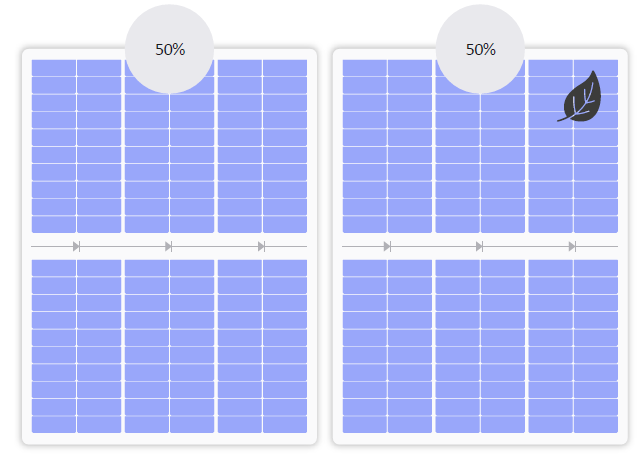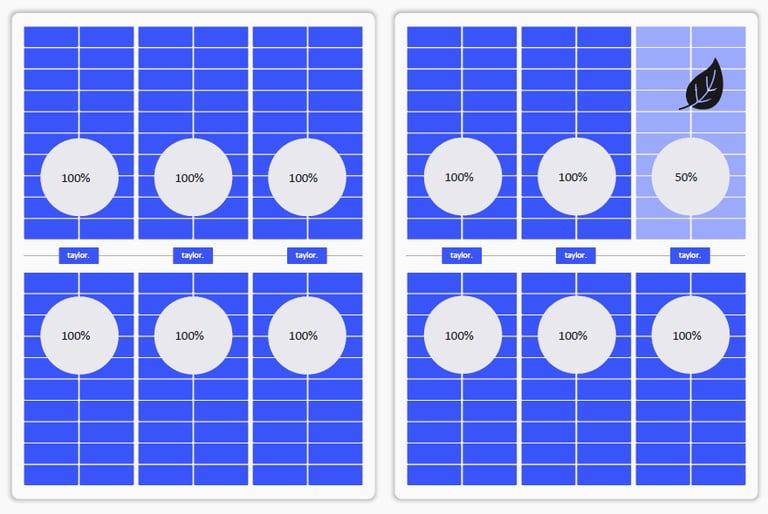Shading Solutions in Solar Panels Sonnex Smart Solar Panels vs. Back-Contact Panels
5/27/2025
Solar panel performance is often affected by shading, whether from trees, buildings, or other obstacles. When even a small portion of a solar panel is shaded, it can cause significant power losses, making shading optimization a critical factor in PV system design.
At Sonnex Energie, we integrate a Cell String Optimizer (by Taylor) with 3 MPPTs into our solar module to actively optimize power output at the cell-string level. This ensures high energy yield, even under partial shading. Meanwhile, back-contact (BC) solar panels—such as IBC, HPBC, or TBC—offer improved shading tolerance over standard modules but lack real optimization capability.
This blog compares the two technologies and explains why back-contact modules should not be considered “optimized” solar panels.
Understanding Shading Optimization in Solar Panels
How Does Shading Affect Solar Panels?
A standard solar panel consists of multiple cell strings connected in series. When shading occurs:
• The entire string’s performance is reduced, even if only a few cells are shaded.
• Mismatched current flow creates hot spots, which can damage the module over time.
• Power losses can reach up to 30%-50%, depending on shading severity.


To address this, solar panel technologies must either tolerate or actively compensate for shading losses.
Sonnex Smart Solar Modules: Active Optimization with 3-MPPT Cell String Optimizer
How Does the Integrated Cell String Optimizer Work?
Sonnex Smart Solar Modules integrate a Cell String Optimizer with 3 MPPTs directly into the panel, connecting 6 cell strings. This advanced design actively optimizes power output at the cell-string level rather than relying solely on the inverter’s MPPT function.
Key Advantages:
✅ Three Independent MPPTs per Module
• If one string is shaded, the other two continue generating power at peak efficiency.
✅ Real-Time Voltage and Current Adjustment
• The Cell String Optimizer automatically adjusts to shading conditions, maximizing overall energy yield.
✅ Hot Spot Prevention
• By redistributing current flow, the optimizer prevents local overheating and extends module lifespan.
✅ Higher Performance in Partial Shading
• Compared to traditional modules, Sonnex Smart Modules lose far less energy when partially shaded.


Ideal Applications:
1.Residential rooftops with occasional shading from chimneys, trees, or other structures.
2.Commercial buildings with different roof angles or partial obstructions.
3. Utility-scale PV farms where shading from clouds or adjacent rows impacts performance.
Back-Contact Solar Panels: Passive Shading Tolerance, Not Optimization
Back-contact solar panels, such as IBC (Interdigitated Back Contact), HPBC (Heterojunction Back Contact), and TBC (Tunnel Back Contact), improve efficiency by placing all electrical contacts at the back of the solar cells. This design:
• Eliminates front-side busbar shading, increasing light absorption.
• Reduces electrical resistance, improving overall efficiency.
• Allows for better current flow across the cell, providing moderate shading tolerance.
Limitations in Shading Conditions:
❌ No Active MPPT Optimization
• Unlike Sonnex Smart Solar Modules, BC panels cannot track and optimize power output dynamically at the cell-string level.
❌ No Independent Cell String Control
• If shading occurs, the entire module still experiences power loss—it cannot isolate shaded areas like an optimized module.
❌ Improved Tolerance ≠ Active Optimization
• While BC panels reduce shading losses compared to standard solar panels, they do not actively adjust power output in real time.
Ideal Applications:
1.Full-sun environments, such as large solar farms or desert installations.
2. Premium efficiency projects, where high efficiency in ideal conditions is prioritized over shading resilience.
Why Back-Contact Solar Panels Are Not “Optimized” Modules
A common misconception is that back-contact panels have built-in optimization—but this is incorrect. Unlike Sonnex Smart Solar Modules with an integrated Cell String Optimizer, BC panels:
• Do not feature MPPT at the cell-string level—power loss from shading affects the entire module.
• Lack independent shading compensation—they cannot dynamically adjust to maximize energy output.
• Improve shading tolerance but do not actively optimize power—their fixed electrical design cannot adapt to changing shading conditions.
What You Need to Know:
✅ Back-contact panels improve efficiency but do not actively optimize power.
✅ Sonnex Smart Solar Modules optimize shading performance at the cell-string level.
❌ Back-contact panels should not be marketed as “optimized” modules because they lack MPPT technology.
Conclusion: Why Sonnex Smart Solar Modules Deliver the Best Shading Performance
If shading is a concern in your solar installation, choosing the right panel technology is critical. While back-contact panels offer improved efficiency, they do not actively optimize power output.
Sonnex Smart Solar Modules, with an integrated 3-MPPT Cell String Optimizer, provide real-time shading optimization, ensuring maximum energy yield in all conditions. This makes them ideal for residential, commercial, and utility-scale solar projects where shading can impact system performance.
Why Choose Sonnex Smart Solar Modules?
✅ 3 MPPTs per module for superior shading resistance
✅ Higher energy output in partial shading conditions
✅ No need for additional optimizers—built-in intelligence
✅ Prevents hot spots and extends module lifespan
✅ Fire safety rapid shut down for safe operation
✅ Advanced insight by monitoring on solar module and cell strings
For PV systems requiring the best shading resilience and maximum power output, Sonnex Smart Solar Modules set a new benchmark in solar optimization.
Want to maximize your solar energy yield? Contact us today to learn more!
info@groadre.com
+86 189 5928 6782
Copyright 2024© GroadRE. All rights reserved. Terms and Conditions | Privacy Policy
Golden Road to Green
